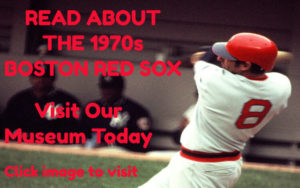1984 Boston Red Sox: Rocket Launch & A Quiet Winning Season
The first half of the 1980s are generally not seen as a high point in the history of the Boston Red Sox, and that characterization is, for the most part, fair. There were no division titles, nor even a noteworthy near-miss. But there were examples of some overachievement and teams that deserve to be remembered well. The 1984 Boston Red Sox were just such a team.
Boston was the midst of retooling its roster for what would ultimately be a five-year run from 1986-90 where they won three AL East titles, a pennant and came within one 10th-inning collapse of winning the 1986 World Series.
By 1984, the team had already integrated Wade Boggs into the everyday lineup at third base. They also had 24-year-old Rich Gedman at catcher, and now they moved young Marty Barrett into the second base spot, phasing out veteran Jerry Remy. The ’84 Sox also gave a shot at shortstop to 24-year-old Jackie Guiterrez.
Gedman hit 24 home runs and slugged .506 in 1984. Barrett hit .303 and had an on-base percentage of .358. Boggs churned out a .407 OBP. The only one of the young players who didn’t make it was Guiterrez. The other three were added to a lineup that included four veteran hitters that all had big years in 1984.
Jim Rice, the future Hall of Famer in left field, hit 28 home runs and had 122 RBIs. On the other side of the outfield, Dwight Evans posted numbers of 32 & 104 respectively, and continued to showcase his rifle arm in the field.
Mike Easler was the designated hitter, acquired in the offseason in a deal for starting pitcher John Tudor, and Easler ended up at 27/91, and had a .376 on-base percentage. And no one produced more than centerfielder Tony Armas, with his 43 home runs and 123 RBIs.
It added up to an offense that ranked second in the American League, excelling at both getting runners on base and then cleaning them up, and balanced with both youth and veterans. The lineup would be further strengthened in June when the Red Sox dealt starting pitcher Dennis Eckersley to the Chicago Cubs for first baseman Bill Buckner.
Pitching was the problem. You might note the trades of Eckersley and Tudor and wonder what the Red Sox were doing. Here, some context is in order. Eckersley was struggling badly as a starter, on the path that would jeopardize his career until a shift to the bullpen in Oakland made him the game’s top closer.
Tudor was a year away from having a dominating year with the St. Louis Cardinals and helping lead them to a pennant. But he had never shown such stuff in Boston, nor did he in Pittsburgh, the place the Red Sox dealt him in the deal for Easler.
There’s no reason to think Tudor or Eckersley in the rotation at Fenway Park in 1984 would have made the Red Sox substantially better than the 86-76 team they ended up being. And there was promise in the pitching rotation for the future.
Oil Can Boyd, who would be the #3 starter on the pennant team of ’86, got his first regular work in the rotation. Bruce Hurst continued his improvement and had a 3.92 ERA. Bob Ojeda and Al Nipper each had ERAs under 4.00.
But the biggest splash came in mid-May when the Red Sox called up a 21-year-old kid from Texas and gave him the ball. That kid’s name was Roger Clemens. The history of baseball and of the Boston Red Sox—in ways both good and bad—would never be the same.
Clemens made his first start on May 15 in Cleveland and dropped a 7-5 decision. He picked up his first career win in Minnesota five days later, working seven innings and giving up four runs in a 5-4 victory. The Fenway crowd got their first look at the phenom on May 26—Clemens was shaky, 6.2 IP and giving up five runs, though he ended up with a no-decision.
It was June 22 in a game against the Toronto Blue Jays—a good team that would finish in second place this season and win the division in 1985—that Clemens won his first game at Fenway. He delivered a complete-game six-hitter and a legend was on its way to being born.
Boston started the season sluggish and was 20-26 on Memorial Day. If they had played in the AL West, there would have been time to recover. But the AL East of the early 1980s was usually the toughest division in any event, and it was even worse in 1984—the Detroit Tigers came out blazing to a 35-5 start. The Red Sox were 16 ½ games out on Memorial Day.
But the team started playing well. They took three of five in a home series with the Tigers, the last a shutout by Boyd. Clemens also pitched well against the team that would roll to a World Series title, going eight strong innings in a 10-2 win. For the final four months of the 1984 season, the Red Sox played steady winning baseball.
Their final 86-76 record was good for fourth in the AL East—but it would have won them the AL West, where the Kansas City Royals snuck out a title with an 84-78 mark. For a rebuilding team in strong division with a historic powerhouse, that’s not a bad legacy for the 1984 Boston Red Sox.


